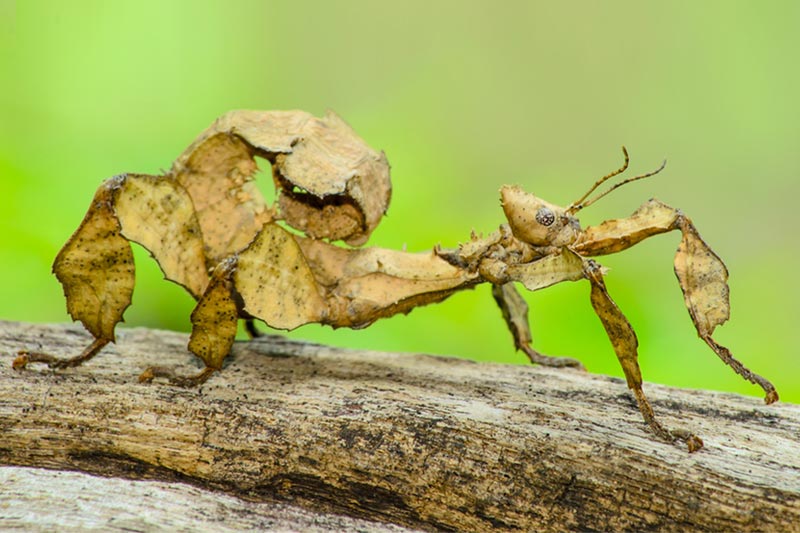If you’re on the hunt for a pet with a difference, you might want to consider adopting an insect or arachnid. These amazing creatures are fascinating to behold and will captivate kids and adults alike. Here’s a look at some brilliant options you can keep in Australia.

Spiny Leaf Stick Insect
These Australian natives have an incredible look. Their outer skeleton has an almost sculptural form and they often shed or moult to reach full size. Males moult five times throughout their life, while females moult six times. This is one of the reasons they are great insects for kids. Another fascinating fact about these insects is that the females are able to reproduce without a male – a process called parthenogenesis.
The Spiny Leaf Stick Insect should be kept in a glass terrarium and fed eucalyptus leaves. The will need a branch in the enclosure so they can moult successfully. You should change the leaves once per week and ensure there is a good amount of humidity in the enclosure using a spray bottle.
Burrowing Cockroach
If you’re thinking about adopting a Burrowing Cockroach, it’s important to keep in mind that they can live for over 10 years! The key to keeping this pet healthy and happy is getting their environment just right. As their name suggests, this creature needs to burrow. This means the enclosure (you could use a fish tank) should be filled with about 10cm of Kritter’s Crumble. The substrate you use needs to be kept moist for the cockroach to draw its daily intake of moisture from. With that though, you need to ensure nothing becomes mouldy in their home. Their habitat should also include elements to hide underneath.
Burrowing cockroaches eat a diet of dry gum leaves as their main source of food, though they can also eat apple, carrot, corm or spinach. They can be handled as they don’t bite, though they can make hissing noises when picked up. Be careful not to handle them too often, as they can feel stressed with too much human contact.
Praying Mantis
These elegant insects are so named because of the way they hold their front legs – they look as though they’re praying. If you’re planning to keep a Praying Mantis as a pet, you will need a glass enclosure with a mix of branches so they can sit or hang. The enclosure needs to be three times longer than your Praying Mantis’s body and two times their height. This space is particularly important for when this insect sheds its skin, which occurs six times throughout their life.
Praying Mantises eat live insects, which you can find at your local Petbarn. You’ll only need to feed your pet every two to three days, being careful not to overfeed them. You won’t need to give your Praying Mantis water as they will take all their required moisture from the insects they eat.
Rhinoceros Beetle
With an amazing look and some pretty incredible skills, the Rhinoceros Beetle is a fascinating pet to adopt. Did you know they can carry 850 times their own body weight? And though they may look a little alarming, they can’t bite or sting you. They eat fruit and sap, so they’ll need a selection of plant/tree matter in their enclosure. You should also provide water for them (perhaps in the lid of a bottle) and you can occasionally mist the enclosure with water to up the humidity levels. Their home should be well sealed, as they can fly – a fish tank or terrarium is advised. You’ll need to add a good depth of soil to the bottom, as well as leaf matter and some branches for your beetle to explore. These beetles make great pets for kids, just be aware that their average lifespan is between eight and twelve weeks.
Australian Featherleg Tarantula
Now a spider is technically an arachnid, not an insect. If you are serious about keeping a spider as a pet, you need to be sure that you are allowed to within your state’s regulations. While not everyone will be keen on your new pet, they are a really rewarding choice due to their uniqueness. Tarantulas are one of the most popular spiders to keep as pets. Please keep in mind that they are mildly venomous and you will need to take special care when deciding to take one on. For this reason, we wouldn’t recommend this spider as a pet for kids.
You’ll need a glass enclosure that has plenty of soil for burrowing as well rocks for them to hide under. They are (obviously) great climbers so make sure your enclosure is well sealed. Tarantulas eat insects, such as crickets, and should have a shallow water dish in their enclosure. They should only be fed about twice per week, but this will also depend on their size. As with all pets, before you commit you really need to do your homework. Be well prepared for everything spider ownership may entail, and you’ll have a super-cool pet.
